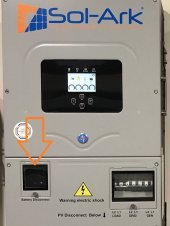That's probably 96% peak efficiency at optimal battery voltage if the moon and stars line up.
Do they publish a curve of efficiency vs. wattage? Family of curves for different battery voltage?
How long in the wiring trough? If more than 2', derating is supposed to be based on that environment.
Is your wire 90 degree C, or 105 degree C? (of course, other wires in the trough will suffer its heating.)
Not sure if code supports it, but my way of thinking is breaker at the far end protects against overload. Even if wire ampacity is lower than near-end fuse rating, if wire is large enough to be the ground wire for a circuit with that fuse, it will hold up long enough to blow the fuse in case of a dead short.
I think your battery can deliver up to 80,000A. You could do some math on the cable resistance, see how much that reduces current for a loop to the first plausible location of a short.
There are longer class-T fuses rated for 600VDC, but the same 20,000 AIC. Shame they don't offer a range of AIC depending on voltage.
The Feraz-Shawmut fuse I have is fast blow semiconductor (i.e. to protect one) fuse, 250A, 50,000 AIC.
Ideally fuses are dual element - fast blow fuse way higher than wire ampacity, to protect in case of a short. Also slow-blow at desired rating for wire ampacity. By using fuse and breaker, I try to divide the job between them. Fuse because it has the higher AIC.
Here's one. $157, 400A, AIC "Breakthrough Current" 100,000A at 250VDC
I guess that's cheaper than four Class-T fuses.
I'm not finding a fuse holder rated above 200A, though.
McMaster-Carr is the complete source for your plant with over 595,000 products. 98% of products ordered ship from stock and deliver same or next day.

www.mcmaster.com
Make sure your busbars have good contact. One guy splattered a busbar without blowing the fuse.






